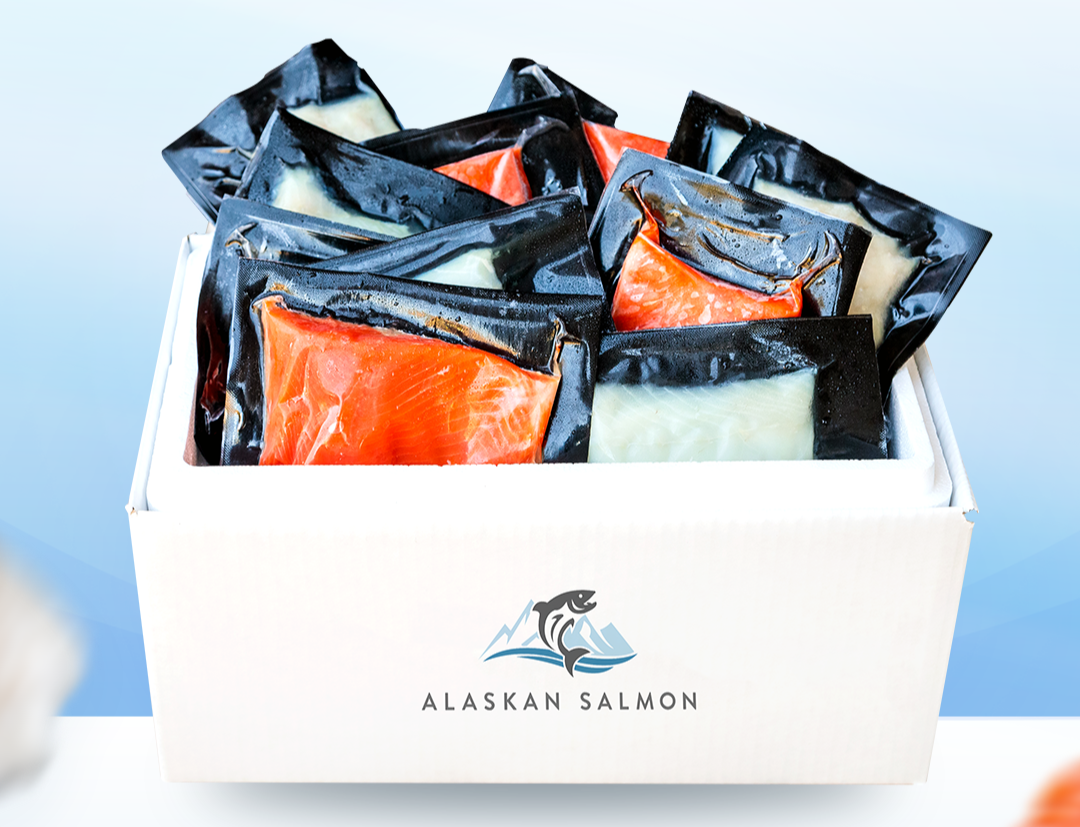What is Sockeye Salmon? Flavor, Nutrition, and Buying Guide
Updated on May 30, 2025
If you’ve ever been confused by the many types of salmon out there, you’re not alone. Sockeye salmon often gets attention for its intense color and flavor — but there’s more to it than meets the eye. This guide explains everything you need to know about sockeye: where it comes from, how it tastes, and how to get the best quality when buying it.
What is Sockeye Salmon?
Sockeye salmon (Oncorhynchus nerka) is a species of wild Pacific salmon renowned for its vibrant red flesh, firm texture, and rich, bold flavor. The name "sockeye" is an anglicization of the Halkomelem word suk-kegh, meaning "red fish," reflecting the fish's distinctive coloration.
Native to the northern Pacific Ocean and the freshwater rivers that flow into it, sockeye salmon are found from Alaska to northern California, with the largest populations in Alaskan waters. They are anadromous, meaning they hatch in freshwater, migrate to the ocean to mature, and return to freshwater to spawn. Typically, sockeye salmon spend one to three years in freshwater before migrating to the ocean, where they live for an additional two to three years.
Related: The Salmon Life Cycle
Their diet primarily consists of zooplankton and small crustaceans like krill, which are rich in astaxanthin — a carotenoid pigment responsible for their deep red flesh and also a powerful antioxidant . During spawning, sockeye salmon undergo a dramatic transformation: their bodies turn bright red, and their heads take on a greenish hue. This striking appearance, along with their remarkable life cycle, makes sockeye salmon both a biological marvel and a cultural icon of the Pacific Northwest.
Related: Salmon Color Guide: Factors Affecting Salmon Color
What Does Sockeye Salmon Taste Like?
Sockeye salmon is known for its bold, robust flavor that stands out among other salmon varieties. It has a rich, full-bodied taste with a clean, slightly briny finish and a hint of natural sweetness. This intense flavor comes from its wild diet, which includes krill and other crustaceans rich in astaxanthin — a compound that not only contributes to its taste but also gives the flesh its signature deep red color.
Unlike milder types of salmon like coho or farmed Atlantic, sockeye has a firm, meaty texture that holds up beautifully to grilling, roasting, or pan-searing. It doesn’t require heavy seasoning or sauces to shine — its natural flavor can carry a dish all on its own. That’s why many chefs and home cooks prefer sockeye when they want a salmon that delivers a rich, satisfying seafood experience.
Related: What Does Salmon Taste Like?
What are the Nutritional Benefits of Sockeye Salmon?
Sockeye salmon is one of the most nutrient-dense fish you can eat, offering a wide range of health benefits in every bite. It’s especially rich in omega-3 fatty acids — essential fats that support heart health, reduce inflammation, and may improve brain function. A typical 6-ounce serving of sockeye salmon contains over 1,000 mg of EPA and DHA combined, making it an excellent source of these critical nutrients.
In addition to healthy fats, sockeye is a powerhouse of vitamin D, which supports bone health, immune function, and mood regulation. It also provides high levels of vitamin B12, necessary for energy production and red blood cell formation, and selenium, a mineral that supports thyroid function and acts as an antioxidant.
One unique benefit of sockeye salmon is its high concentration of astaxanthin — a natural pigment from its diet of krill and other crustaceans. Astaxanthin doesn’t just give sockeye its signature red color — it’s also a potent antioxidant that may benefit skin health, eye function, and endurance.
And because sockeye salmon is always wild-caught, it’s typically leaner than farmed varieties and free from antibiotics or artificial dyes.
Related: 8 Health Benefits of Salmon
Kyle’s Tips for Buying Sockeye Salmon
Buying sockeye salmon online can be a game changer, but only if you know what to look for. Over the years, I’ve learned to spot the difference between average and premium quality — and when it comes to sockeye, the details matter.
First, make sure it’s wild-caught. Sockeye can’t be farmed, so if it doesn’t clearly say “wild,” that’s a red flag. The best sockeye usually comes from Alaska, where fishing standards and sustainability practices are top-notch.
Related: Wild Caught vs. Farm Raised Salmon: What’s the Difference?
Second, check how it’s been frozen. “Flash-frozen” or “frozen-at-sea” means the fish was frozen quickly after being caught, which locks in freshness. Avoid anything vague like “previously frozen” without more details.
Third, inspect the packaging. Vacuum-sealed or tightly wrapped portions help protect the salmon from freezer burn during transit. And of course, read reviews—especially if you’re buying from a site for the first time. For more tips, check out our guide on how to buy salmon online so you know exactly what to look for when shopping smart. Reliable sellers are proud of their sourcing and often give you exact catch locations and handling info.
When your order arrives, keep it frozen until you’re ready to thaw it in the fridge overnight. It’s a simple routine, but it makes all the difference when you want that restaurant-quality salmon at home.
How to Cook Sockeye Salmon
Sockeye salmon’s firm, lean texture makes it incredibly versatile in the kitchen, standing up well to a variety of cooking methods. Whether you prefer it grilled, baked, or pan-seared, sockeye delivers bold flavor and satisfying texture when cooked properly.
Grilling brings out its natural smokiness and adds a slight crisp to the exterior. Simply brush the fillet with olive oil, season with salt and pepper, and place it skin-side down on a preheated grill for about 5–6 minutes per side.
Related: How to Grill Salmon Perfectly
Baking is a gentle option that helps preserve moisture. Cook the salmon at 375°F (190°C) for 12–15 minutes, optionally adding herbs, lemon slices, or a light glaze for extra flavor.
Related: How Long to Bake Salmon at 400°F
Pan-searing is ideal if you want a crisp crust and juicy center. Heat a skillet over medium-high heat with a bit of oil, sear skin-side down for 4–5 minutes, then flip and finish for another 2–3 minutes.
Related: How to Pan Fry Salmon
Because sockeye is leaner than other salmon varieties, it’s important not to overcook it. Cook just until the fish flakes easily with a fork — usually when the internal temperature reaches 125°F (52°C).
These simple techniques highlight the natural richness of sockeye salmon, making it a favorite for both quick weeknight meals and special occasions.
How to Store Sockeye Salmon
Proper storage is key to maintaining sockeye salmon’s freshness, flavor, and nutritional value. Whether you’ve bought it fresh or frozen, handling it correctly ensures a better eating experience.
For fresh sockeye salmon, keep it refrigerated at a temperature between 32°F and 38°F (0–3°C). Store it in its original packaging or wrap it tightly in plastic wrap or foil to minimize air exposure. Fresh salmon should ideally be cooked within 1 to 2 days of purchase.
If you need to store it longer, freezing is a great option. Wrap the salmon tightly in freezer-safe packaging or use vacuum sealing to prevent freezer burn. For best quality, keep it at 0°F (-18°C) or below. Sockeye salmon can be frozen for up to 2–3 months without a major loss in flavor or texture.
When it’s time to cook, thaw the salmon slowly in the refrigerator overnight. Avoid thawing at room temperature, as it can affect texture and food safety. Once thawed, it should be cooked within a day.
Following these steps helps preserve sockeye salmon’s rich taste and firm texture, whether you’re storing it short-term or for later use.
Related: Salmon Storage Tips: How Long Salmon Lasts in the Fridge
Sockeye Salmon FAQs
Is sockeye salmon always wild-caught?
Yes, sockeye salmon is always wild-caught. Unlike other salmon species, sockeye does not adapt well to aquaculture due to its complex migration patterns and spawning needs.
Why is sockeye salmon red?
Sockeye salmon is red because of its diet, which is rich in tiny crustaceans called krill that contain a natural pigment called astaxanthin. This pigment accumulates in the fish’s flesh, giving sockeye salmon its distinctive deep red color. Astaxanthin is also a powerful antioxidant that benefits the salmon’s health and contributes to its vibrant appearance.
Can you eat sockeye salmon raw?
Yes, you can eat sockeye salmon raw — but only if it’s been properly handled and frozen to eliminate parasites. Look for salmon labeled as sushi-grade or sashimi-grade, which meets the standards for safe raw consumption. Sockeye’s firm texture and clean flavor make it a favorite for raw dishes like sushi, poke, and sashimi.
Related: Where to Buy Sushi-Grade Salmon?
Is sockeye salmon better than Atlantic salmon?
Many people prefer sockeye for its wild origin, firmer texture, and stronger flavor. Atlantic salmon is usually farmed and milder.
Summary
Sockeye salmon stands out for good reason. With its vivid red flesh, bold flavor, and impressive nutritional benefits, it’s no surprise this wild Pacific fish is a favorite among seafood lovers. From its unique life cycle and antioxidant-rich diet to its versatility in the kitchen, sockeye offers more than just taste — it delivers a rich experience backed by science and tradition.
Whether you're new to sockeye or looking to upgrade your usual seafood picks, choosing a high-quality source makes all the difference. At Alaskan Salmon Company, we offer Wild Alaskan Sockeye Salmon that’s flash-frozen and delivered straight to your door. Explore our shop to taste the difference and enjoy premium seafood, anytime.








